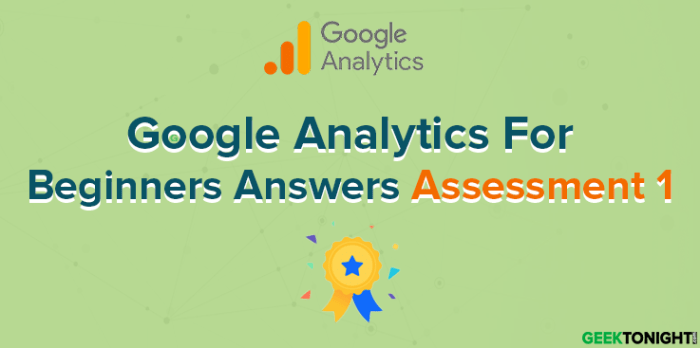Google analytics for beginners answers – Welcome to the realm of Google Analytics for beginners! Embark on a journey of discovery as we delve into the intricacies of this powerful tool, unlocking the secrets to optimizing your website’s performance. From understanding key metrics to leveraging advanced features, this comprehensive guide will empower you with the knowledge and insights to make informed decisions and drive tangible results.
Google Analytics empowers businesses of all sizes to gain invaluable insights into their website’s traffic, user behavior, and conversion rates. By harnessing this data, you can identify areas for improvement, enhance user experience, and ultimately maximize your website’s potential.
1. Introduction

Google Analytics is a free web analytics service that helps businesses understand how their website is performing. It provides insights into who is visiting your website, what they are doing on your website, and where they are coming from. This information can be used to improve your website’s performance and marketing campaigns.
There are many benefits to using Google Analytics, including:
- Improved website performance: Google Analytics can help you identify areas of your website that are performing well and areas that need improvement.
- Increased traffic: Google Analytics can help you understand how people are finding your website and what they are doing when they get there. This information can be used to improve your website’s visibility and attract more visitors.
- Better marketing campaigns: Google Analytics can help you track the results of your marketing campaigns and see what is working and what is not. This information can be used to improve your marketing ROI.
Here are some examples of how Google Analytics can be used by businesses:
- A retail store can use Google Analytics to track how many people are visiting their website, what products they are looking at, and how long they are staying on the site. This information can be used to improve the store’s website and marketing campaigns.
- A blog can use Google Analytics to track how many people are reading their blog posts, what topics they are interested in, and where they are coming from. This information can be used to improve the blog’s content and marketing campaigns.
- A nonprofit organization can use Google Analytics to track how many people are visiting their website, what pages they are viewing, and how long they are staying on the site. This information can be used to improve the organization’s website and fundraising campaigns.
- Sessions: A session is a group of user interactions with your website that take place within a given time frame. A session can include multiple pageviews, events, and transactions.
- Users: A user is a unique individual who visits your website. A user can have multiple sessions.
- Pageviews: A pageview is a view of a single page on your website. A pageview can be part of a session or it can be a standalone event.
- Bounce rate: The bounce rate is the percentage of visitors who leave your website after viewing only one page.
- Identify pages that have a high bounce rate.
- Identify pages that are not converting visitors into customers.
- Identify pages that are loading slowly.
- Identify pages that are not mobile-friendly.
- Redesign pages that have a high bounce rate.
- Add more content to pages that are not converting visitors into customers.
- Optimize pages that are loading slowly.
- Make pages mobile-friendly.
- Custom dimensions: Custom dimensions allow you to track additional information about your website’s visitors. For example, you could create a custom dimension to track the type of device that your visitors are using.
- Custom metrics: Custom metrics allow you to track specific events that occur on your website. For example, you could create a custom metric to track the number of times that a visitor clicks on a particular button.
- Event tracking: Event tracking allows you to track specific user interactions with your website. For example, you could track the number of times that a visitor clicks on a link or plays a video.
2. Getting Started with Google Analytics
To get started with Google Analytics, you need to create a Google Analytics account. You can do this by visiting the Google Analytics website and clicking on the “Sign up” button. Once you have created an account, you need to add your website to Google Analytics.
You can do this by clicking on the “Admin” tab and then clicking on the “Property” tab. On the Property tab, click on the “Add property” button and then enter your website’s URL. Once you have added your website to Google Analytics, you need to install the Google Analytics tracking code on your website.
You can do this by following the instructions on the Google Analytics website.
Once you have installed the Google Analytics tracking code on your website, you can start collecting data about your website’s visitors. You can view this data by logging into your Google Analytics account and clicking on the “Reports” tab. The Reports tab contains a variety of reports that you can use to learn more about your website’s visitors.
3. Understanding Google Analytics Metrics

Google Analytics tracks a variety of metrics that can be used to measure your website’s performance. Some of the most important metrics include:
It is important to understand these metrics and how they can be used to improve your website’s performance. For example, if you have a high bounce rate, it means that visitors are leaving your website after viewing only one page.
This could be due to a variety of factors, such as a poorly designed website or irrelevant content. You can use Google Analytics to identify the reasons for your high bounce rate and then take steps to improve your website.
4. Using Google Analytics for Website Optimization: Google Analytics For Beginners Answers

Google Analytics can be used to identify areas of your website that need improvement. For example, you can use Google Analytics to:
Once you have identified the areas of your website that need improvement, you can take steps to make changes. For example, you can:
By making changes to your website based on Google Analytics data, you can improve your website’s performance and achieve your business goals.
5. Advanced Google Analytics Features

Google Analytics offers a variety of advanced features that can be used to track specific user behaviors and events. These features include:
These advanced features can be used to gain a deeper understanding of your website’s visitors and how they interact with your website. This information can be used to improve your website’s performance and marketing campaigns.
Question Bank
What is Google Analytics?
Google Analytics is a free web analytics service offered by Google that provides website owners with insights into their website’s traffic, user behavior, and conversion rates.
How do I create a Google Analytics account?
To create a Google Analytics account, visit the Google Analytics website and follow the step-by-step instructions. You will need to provide your website’s URL and some basic information about your business.
What are the benefits of using Google Analytics?
Google Analytics provides a wealth of benefits, including the ability to track website traffic, identify areas for improvement, enhance user experience, and optimize marketing campaigns.